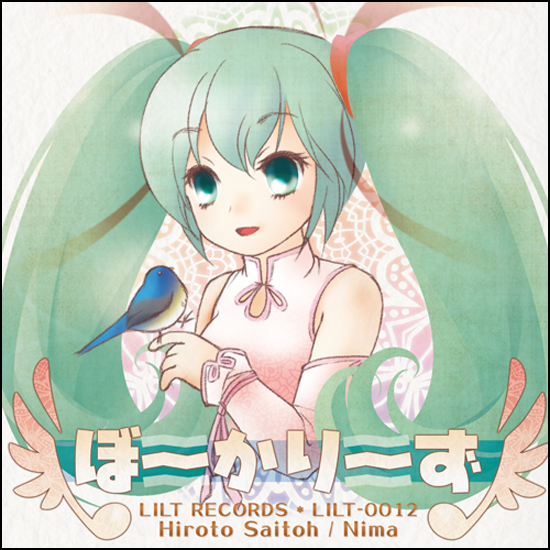I’m going to start calling him Hiroto Saitoh of many colors. Yes, that’s a Lord of the Rings reference for the two of you out there who know what I’m talking about. We’ve had the pleasure of checking out a lot of Saitoh’s releases from his record label, LILT Records. He’s done RPG-themed stuff with Cross Hermit, bossa nova with Dia Novo and Melodia, and the synthesizer-based Retrospective Blue.
Not one to miss Comiket, Saitoh released two albums at Comiket 77 last month: his Japanese-flavored soundtrack for Usotsuki to Inugamitsuki and this original album, Vocalize. From the time, you can probably gather what it’s all about: vocaloid. It’s appropriately cheery and cute, but also spans a number of musical styles. I realize vocaloid isn’t everyone’s cup of tea, but if that’s you, perhaps you should consider giving Vocalize anyway.
Find out why I think so after in our review after the jump!
First of all, I’m an amateur when it comes to vocaloid music. Miku Hatsune is listed as the vocalist for this album, and I was fascinated to find out that this isn’t actually a person, but rather, a synthesized singer created by Yamaha’s vocaloid software with clips from singer Saki Fujita. Isn’t that awesome?
I suppose most people think of vocaloid music as being ultra-sweet and happy, and for the most part, the vocals are, but Saitoh’s diverse musical backings really make this album what it is. It’s actually more laid back than anything with tracks like the dreamy bossa nova adventure, “Winter to Lead to the World’s End,” and the smooth jazz excursion, “Reflection.”
Taking a step back, the opening track, titled “Lycoris Radiata,” features energetic piano progressions and some killer organ to accompany the contemplative yet perky vocals. This track reminds me a whole lot of Castlevania with the organ and the rockin’ electric guitar solo that comes in about half way through the track. It’s a great intro, and probably one of my favorite songs on the album, and it’s not overbearing at all.
Oh, and there’s chip music too. “Midnight Journey” is a spacey chip track with some lovely arpeggios and sound effects, and admittedly the most difficult-to-handle vocals on the entire album. The soft and high pitch on the vocals almost sound like disgustingly sweet baby-talk, which I personally can forgive based on the awesome musical backing, but I know that others will be less forgiving. “pole pole” is also chip in style, and actually references some Frederic Francois Chopin, sounding almost like a lovely 8-bit lullaby.
The next track, “Tender…,” takes us into J-pop territory, starting with a piano ballad before moving more into rock with clicky percussion and distorted electric guitars. “Night Bird Addict” is straight up funk with a groovin’ bassline and synthesized brass sounds that sound a little too close to the 007 theme!
The last track on the album is “Prayer’s Song to Snowflakes,” a folksy “town” tune with woodwinds, acoustic guitar, and tambourines. It sounds like a sleepy village theme right out of an RPG soundtrack. It’s Celtic-inspired, and absolutely beautiful. The pitch-bendy vocals trail off into the distance, blending perfectly with the woodwinds. What a way to close out an album.
Well, sort of. The album actually ends with instrumental versions of several of the tracks, including “Reflection” and “Prayer’s Song to Snowflakes.” It’s nice to hear Saitoh’s compositions on their own, and they’re all great, but after hearing the vocaloid versions, I have to say I prefer them to the instrumental ones. It’s still a nice bonus. I think fans who hate vocaloid music can at least appreciate these, especially when it comes to “”Prayer’s Song to Snowflakes.”
I’d actually known about this album for some time. I wasn’t quite sure how it’d turn out, but Hiroto Saitoh has made a believer out of me. There are so many different styles represented here that it’s difficult to call it “vocaloid.” While I understand that this style of vocals bugs some people to no end, I suggested giving this one a try as I promise it’s not the vocaloid that you’ve come to expect. There’s also some great cover artwork from LILT Records’ Nima, who always does a fantastic job, so I recommend picking this one up if you get the chance!
Are you generally a fan of vocaloid music? What do you think of Hiroto Saitoh’s experiment, and would you be interested in picking it up if it were widely available?
[Track titles translated by Nima at LILT Records]
Tags: Celtic, Chiptunes, Hiroto Saitoh, LILT Records, Music Reviews, Nima, Reviews, Vocalize, Vocaloid









































Where can I buy these albums? I’m always desperately searching for a purchase link in these review posts.
Unfortunately they only sell these at Comiket as far as I know. Maybe we should talk to them about selling CDs through OSV, huh? ;D
Hell yes, please do.